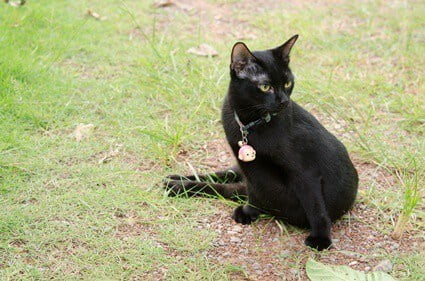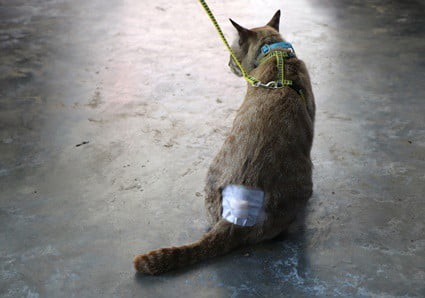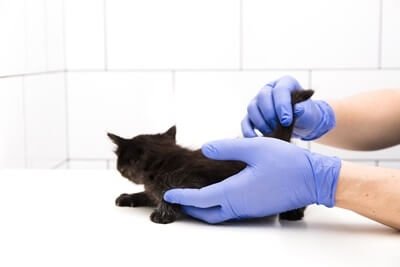An upright tail is always a welcome sight in cats. A feline that holds its tail high and proud is feeling healthy and confident. This means that a cat’s tail drooping or dragging on the ground is a concern. It must be determined if this sudden tail limpness is voluntary or due to an injury.
Cats sometimes drag their tales along the ground deliberately due to emotional discontent. If the cat is physically unable to lift its tail, one of the bones in the appendage may be broken. Alternatively, the cat may have dislocated its tail from the base of the spine.
There is a difference between a cat being unwilling to lift its tail and being physically unable to do so. The former, while concerning, can be connected to a lifestyle concern and easily resolved. If your cat is physically incapable of lifting its tail, your cat will need to be examined by a veterinarian.
Why Do Cats Lift Their Tails?
Cats’ tails are among the most expressive parts of feline anatomy. An experienced owner can often detect the mood of their pet through its tail.
Typically, a tail held high and prominently means that the cat is happy and contented. If the tail is curled like a question mark, the cat is saying hello to you. This is a common position when you return home after a prolonged absence. Cats also lift their tails for a range of reasons unconnected to emotions. Common reasons for cats to lift their tails include:
| Elimination: | Cats are fastidiously clean, so they lift their tails in the litter box when eliminating to avoid staining. |
| Marking: | Cats have scent glands close to the base of their tail. These glands are used to claim territory. |
| Greeting Other Cats: | Cats like to show each other their bottoms. This is an invitation to scent happy pheromones. |
| Attracting Attention: | If your cat is hungry or wants to play, it will make itself look large so that it can easily be seen. |
| Fear or Aggression: | Be mindful of the tail is puffed out. This is the cat making itself look large and intimidating. |
Tail-lifting is almost always a voluntary action from cats. As per the Journal of Anatomy, cats have more muscles in and around their tail than almost any other mammal. Several of these muscles are used in any movement.
Felines do not wag their tails in an excitable frenzy, comparable to canines. If a cat chooses to lift its tail or, arguably even more importantly, it chooses not to do so.
Why is My Cat’s Tail Hanging Down?
Having established why cats lift their tails, we should now look into the opposite behavior. What causes a cat’s tail to go limp? This could be an issue with anxiety or unhappiness or due to physical trauma. Either way, your cat needs help.
Like most animals, a nervous cat will keep its tail low. It may even be tucked between the legs. Investigate if something is making your cat uncomfortable or uncertain. Common explanations for cats to feel nervous include:
| Loneliness or Mourning: | Cats are not as solitary and independent as they appear. Your cat may be pining for a lost companion or former owner. |
| Victim of Bullying: | Multi-pet households fall into natural dominant and submissive dynamics. Ensure this does not cross the line into bullying. |
| External Threats: | Cats have acute senses of scent and hearing. Your cat may smell a dog outside or be unnerved by loud noises in the distance. |
| Changes to Routine: | Have you changed your working shift patterns, moved home, or adjusted mealtimes? Change makes cats feel anxious. |
| Unpleasant Impending Experience: | If your cat saw you pick up its carrier, it associates this with a trip to the vet. This will make the cat nervous and worried. |
A low tail can also be a sign that a cat is feeling defeated. Felines like to feel in control of their affairs, so if your cat feels resigned to a life of bullying and misery, it’s no quality of life at all.
Do not make the mistake of believing that a low tail is always a sign of meekness, though. Just as a high, prominent tail could denote happiness of aggression, the same is true of a low position.
Hunting cats keep their tails low and often swish them from side to side, ahead of pouncing on prey. Your cat may be preparing itself for an attack, usually as an act of self-defense.
Of course, this is all assuming that your cat is willfully keeping its tail low to the ground. You must learn if this action is voluntary. If your cat is physically unable to lift its tail, it is automatically more concerning.
Why Isn’t My Cat’s Tail Moving?
As mentioned, whether a cat’s tail is held tall and proud or low and innocuous, it should be a conscious decision. The tail should, at the very least, twitch and vary in position. What does it mean when a cat’s tail doesn’t move? Often, a completely static tail is a sign of trauma.
This could be an injury to the tail or lower back, such as dislocation or a break or fracture. Alternatively, it may be connected to nerve damage. There are tests that you can run to see if a cat is capable of moving its tail. These include:
- Look for signs of physical damage to the cat tail. Swelling at the base is a common symptom.
- Pet the cat from head to tail. Cats with base of tail pain will react poorly to being touched here. Expect to be scratched or hissed at.
- Encourage your cat to eliminate. This will instinctively result in a lifting of the tail.
- Play with your cat. This should see a natural movement of the tail as part of the interaction.
Injuries to Cats’ Tails
Impact trauma can render cats unable to lift their tail. Typically, this symptom will arise from dislocation of the tail or a broken or fractured bone. In some rare cases, the issue may be with the cat’s spinal cord. Cats’ tails are delicate and can be injured in many ways. Common reasons for cats to experience tail trauma include:
- Slammed in a door
- Stepped on by an owner
- Yanked, usually by a playful child
- Bitten or pulled in conflict with another animal
- Degloved
At the first sign of tail trauma, apply first aid. As per Veterinary Clinics of North America: Small Animal Practice, tail injuries frequently lead to pelvic issues. Your cat will be in pain and may not heal appropriately without assistance.
Does My Cat Have a Back Problem?
You must always eliminate the prospect of a spinal injury. This will have a range of consequences beyond an inability to lift the tail. Falls from height or road traffic accidents are the most common explanation for a feline spinal injury.
A cat’s tail is linked directly to the vertebrae, in addition to a range of muscles, tendons, and ligaments. If the cat’s spine is injured, this can have a knock-on effect on the tail. The lower the back injury, the likelier the cat will be unable to lift its tail. Other than the inability to lift the tail, warning signs that your cat is living with a back injury include:
- Uncoordinated, ungraceful gait
- Incontinence (cecal and/or urinary)
- Inability to groom
- Muscular spasms
- Refusal to move
- Reluctance to be touched, including uncharacteristic aggression when petted
- Hunching over
- Refusing food and water
- Excessive verbalization to express pain
Felines can be masters of hiding pain or discomfort. If you suspect that your cat has a back injury, consult a vet. If it deteriorates further, your cat may be permanently immobilized.
If your cat does not appear to have a back injury, the issue will be localized to the tail. This has a better prognosis than spinal trauma but must still be taken seriously. Your first step will be to identify the type of injury.

Is My Cat’s Tail Dislocated?
Cats’ tails are delicate and easily dislocated, especially when pulled or tugged. The tail is connected to the backbone. This part of feline anatomy is known as the tailbone (sacrum).
A cat’s spinal cord concludes at around the fifth vertebrae. After this, tendons connect the back and tail. This is sometimes referred to as the cauda equina, or “horse’s tail.” This means that tugging and dislocating a cat’s tail is likely to result in nerve damage.
This will be extremely painful for the cat and likely result in loss of bladder and bowel control. The sooner the cat is treated, the likelier a full recovery becomes as nerve damage is minimized. Unfortunately, it isn’t easy to reset a dislocated tail. Your cat may never regain full control.
Is My Cat’s Tail Broken?
Cats have between 19 and 21 bones in their tail. These are known as the caudal vertebrae. A break or fracture to any of these bones can leave a feline unable to lift its tail. The lower the impacted vertebrae, the likelier the cat will be unable to lift its tail.
As per a study of 51 cats with tail fractures published in Veterinary Surgery, incontinence is the most common symptom of a break. Alas, a break or fracture in a cat’s tail may not be immediately obvious.
Even a slight droop in the tail’s position may indicate this injury. Fractures to a cat’s tail are frequently divided into 5 categories of varying severity:
| Level 1 (Very Mild): | Slight pain in the head of the tail. Full recovery is expected with minimal discomfort |
| Level 2 (Mild): | Lack of mobility in the tail. This will be painful, but the cat should recover in full with care |
| Level 3 (Moderate): | Lack of mobility plus difficulty urinating. The cat needs urgent care but should make a full recovery in time |
| Level 4 (Serious): | Lack of tail mobility and fecal incontinence. Most cats recover in full, but nerve damage is likely. Special care will be required |
| Level 5 (Chronic): | Lack of mobility plus no control over bowels. Nerve damage is almost certain, leaving a 50/50 chance of survival |
Do not assume that your cat’s tail injury is capped at level 1 and move along. Any form of tail trauma merits a full x-ray investigation. This will reveal the extent of any damage and ensure the cat gets the right treatment.
Usually, the break will need to heal itself over time, but your cat will need painkillers in the meantime. You may also need to apply a splint to keep the tail elevated, preventing any difficulty with elimination.
Other Cat Tail Injuries
It’s not only impact injuries that leave cats unable to lift their tails. Outdoor cats, in particular, will encounter other animals. These interactions will not always be friendly.
If a cat fights with a neighborhood feline, a dog, or even a wild raccoon, they may be bitten on the tail. This can lead to viral infection due to bacteria found in the other animal’s mouth.
If your cat has a wound on its tail, wash the area with antibacterial soap. Apply a bandage too. If your cat cannot lift its tail after this, your cat likely needs a course of prescription antibiotics.
These conflicts can result in abscesses. In this case, clip the fur around the abscess and apply a warm flannel. Repeat this process thrice daily. In theory, this will drain the abscess – though, as before, antibiotics may also be required.
Cats can also burn their tails. For example, if your cat frequents the kitchen, it may burn its tail on a stove or hob. Apply a cold compress to the burned area, then visit a vet.

Will My Cat’s Tail be Amputated?
The healing of a cat’s tail injury is a notoriously slow process. It can take up to 6 months before your cat makes a full recovery. If this will dramatically reduce your cat’s quality of life, a vet may recommend amputation for the cat’s safety.
You’ll know if a cat is set to recover in full within a month. It may not have full control over its tail after four weeks, but at a minimum, pain and discomfort should subside. This timeframe will also reveal any long-term nerve damage.
If a cat is experiencing fecal or urinary issues beyond a month, it is unlikely ever to cease doing so. At this point, amputation is often considered the best course of action.
If a cat cannot lift its tail and has difficulty eliminating properly, it will regularly soil its tail. This will be stressful for the cat, in addition to being dangerous. The odor will attract flies, leading to the risk of flystrike.
A cat that undergoes tail amputation will live a full and normal life. It may take the cat a few weeks to fully master its balance without a tail. With time and patience, the cat will eventually forget that it underwent this major surgery.
If your cat cannot lift its tail, check its general mood and demeanor. This should reveal if the issue is emotional or physical. In the latter case, ensure the problem is rectified. Tail trauma can have long-term repercussions if ignored.


Please someone help me my cat her tail is all the way down i have tried evything.tuna,a yarn string, cleaning my cat’s litter, picking her up and putting her on my bed and petting her, putting on cat calming music. i have searched the internet just wanting to find out what is happening to her. if anyone can help me please let me know. also, we have three cats the one is the one that is all the thing going on to her she seems so distant a don’t know if she is mad at me or the new kitten of the new dogs, she lived me me all of my life please help me